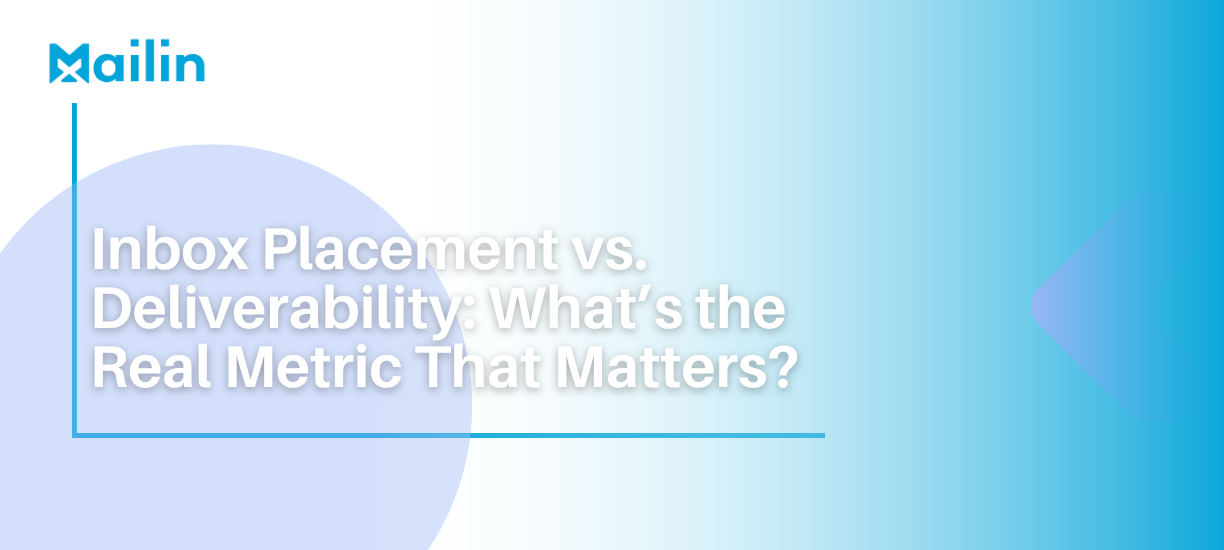Inbox Placement vs Deliverability: Why the Difference Matters for Your Cold Email Campaigns
If you’re sending cold emails or any kind of outreach, you’ve probably heard the terms deliverability and inbox placement thrown around a lot. They might sound similar, but mixing them up can cost you valuable leads and engagement.
Let’s clear up the confusion and focus on the metric that truly drives your email campaign’s success.
What’s the Difference?
Deliverability refers to whether your email successfully reaches the recipient’s mail server without bouncing. If your email doesn’t bounce, it’s considered delivered.
Inbox placement, on the other hand, is about where your email lands after it’s delivered. Does it show up in the recipient’s main inbox, their promotions tab, or worse—the spam folder?
Why does this matter? Because emails that land outside the primary inbox often get ignored or deleted.
Why Do People Confuse These?
Most email marketing and outreach platforms report deliverability rates prominently. It’s easy to celebrate a 99% deliverability rate and assume your campaign is performing well. But here’s the catch:
High deliverability doesn’t guarantee high inbox placement.
Your emails might be delivered to the server but get routed to spam or promotional folders where open and reply rates plummet. This disconnect leads to wasted effort and missed opportunities—the exact opposite of what your cold email campaigns should achieve.
Which Metric Should You Really Care About?
Inbox placement is the metric that impacts your opens, replies, and conversions—everything that matters for campaign ROI.
Imagine this:
You send 1,000 emails.
99% are delivered (only 10 bounce).
But only 20% land in the recipient’s main inbox.
That means effectively only 200 emails have a real chance of being seen and engaged with. A campaign like that will struggle, regardless of how great your copy or offer is.
How Can You Track Inbox Placement?
Inbox placement isn’t always obvious but here are some practical ways to get insight:
Seed List Testing Tools:
Services like Mailreach, Folderly, and GlockApps let you send your campaign to a list of test accounts across Gmail, Outlook, Yahoo, and more. They then report exactly where each email landed.
Analyze Behavior Metrics:
If your open rates are decent but reply or click-through rates are very low, it could be a sign your emails are stuck in promotions or spam.
Manual Testing:
Send your campaign emails to various personal or team inboxes on different platforms (Gmail, Outlook, Apple Mail, etc.) and check where they land. This hands-on method gives direct feedback and helps you spot issues early.
What Affects Inbox Placement?
Inbox placement is influenced by many factors, often working together:
Technical Setup
Your sending domain must have properly configured SPF, DKIM, and DMARC records. These verify you’re a legitimate sender and help prevent spoofing. Incorrect or missing records harm your reputation and inbox placement.
Tools like Mailin simplify this setup, avoiding complex DNS headaches.
How Fast You Scale Sending Volume
New domains and mailboxes need to be warmed up gradually. Going from zero to 5,000 emails overnight looks suspicious to providers and triggers spam filters.
A recommended warm-up timeline:
-
At least 3–4 weeks for gradual volume increases.
-
Microsoft inboxes often require longer domain age and warm-up periods to avoid spam traps.
Email Content Quality
Spam filters scan your content for:
-
Spammy keywords (e.g., “free,” “buy now”)
-
Excessive images or links
-
Poor formatting or all caps
-
Lack of personalization
Write clear, simple, human-sounding emails. Avoid gimmicks and focus on value.
Domain and IP Reputation
If too many recipients delete your emails unread, mark them as spam, or never engage, providers start routing your messages to junk by default. Encouraging replies, clicks, and interactions builds trust and improves placement over time.
List Quality
Sending outdated or invalid emails causes bounces and damages your reputation. Use list cleaning tools like Millionverifier or Bounder regularly to keep your lists fresh and accurate.
Why Mailin Is Great For Cold Emailing
Mailin is designed with deliverability challenges in mind — especially for high-volume senders:
-
Dedicated servers and IPs: Your sending reputation is isolated, reducing the risk of being affected by other senders on shared infrastructure.
-
24/7 deliverability support: Our team helps you monitor and resolve inbox placement issues, saving you from hiring expensive deliverability consultants (who typically charge $80–$150/hr).
-
Robust backend infrastructure: Mailin is built to maintain both high deliverability and inbox placement performance at scale.
-
Easy integrations: Works seamlessly with platforms like Clay, Smartlead, and Instantly to streamline your outreach workflow.
Wrapping It Up
Deliverability rates are a useful starting point, but they don’t tell the full story.
Inbox placement is the real metric that determines whether your emails get opened, read, and acted upon.
To improve it, focus on:
-
Proper technical setup (SPF, DKIM, DMARC)
-
Slow, methodical warm-up of new domains and mailboxes
-
Clean, relevant, human-sounding email content
-
Maintaining a clean, verified email list
Tools like Mailin make this easier, but your strategy and discipline matter just as much.
Don’t just deliver emails. Get them read, replied to, and converted.



 Back
Back